Archive for ‘Books and Reading’ Category
6 Resources to Read More Books, Drop By Drop
In 1841, throngs of New Yorkers, old money and new immigrants, alike, swarmed the docks to ask arriving travelers from England whether Little Nell in Charles Dickens’ The Old Curiosity Shop was alive or dead. Before the book was available as, per se, a book, it had been serialized, weekly, as many Victorian-era novels were published in installments in magazines and newspapers. Dickens’ own The Pickwick Papers had proven the initial success of the serialized format, and everything from Alexander Dumas’ The Count of Monte Cristo (139 installments) to Harriet Beecher Stowe’s Uncle Tom’s Cabin (forty weekly installments) gained popularity by percolating readers’ coffee-like addiction to the stories, drop by drop.
The past two Paper Doll posts covered organizing your reading space for more reading time and offered 12 tips for organizing your reading time. At the end of the latter post, I noted that reading in micro-bursts was one way for busy people to squeeze reading opportunity into daily life. Today, we’re going to look at some technology to assist in that very goal.
DailyLit is an online service that helps you read both literary classics and new fiction in short installments, entirely at your convenience. It’s the oldest and largest distributor of serialized fiction, dating back to 2006. As of 2013, it’s owned by Plympton, Inc., a San Francisco-based media technology company now immersed in digital publishing.
The process is simple. Sign up with your email address to create your account. From there, you browse the DailyLit categories or book selections by title, author, recency of addition or rating. When searching by author, you can also drill down by publication date and price (if there is any).
Choose a book that tickles your fancy, then determine how often and when you want each installment to arrive in your email inbox. If you get so engrossed in the story that you can’t wait until your next delivery, you can click “next installment” to jump to the next nibble. If you’re too overloaded with work or life to even read one installment and you need to take a break for a while, you can log into your account to pause delivery until you’re eventually ready to resume reading — in a day, a week, or whenever.
Installments generally take under twenty minutes to read, and you can read each installment wherever and however you normally check your email — on your computer at work, on your phone while waiting in line or for a meeting to start, or on your tablet, scrunched down into your sofa. You’re already reading email throughout the day, so having an oasis of calm (or a thriller, if that’s your preference) pop up amid the project updates and meeting requests can boost your mood as well as your reading progress. If you choose, you can skip your email and opt to read an installment through your browser on the book’s DailyLit page.
A DailyLit account is free, as are many of the books, which are either in the public domain (like pre-1923, out-of-copyright classics), under Creative Commons licenses, or by arrangement with specific publishers. Conversely, most of the modern titles, still under copyright, are only available for serialization for a fee, generally between $1.99 and $4.99.
Literary categories include broad themes (classics, contemporary) as well as genres (science fiction, horror, mystery, humor and satire) and special topics, including banned books and coming-of-age novels.
The service also offers DailyLit Originals, serialized novels and short story “bundles” written by award-winning and emerging authors. The Originals are designed to be read in short installments delivered over the course of about a month.
Rooster is an iOS app-based service which combines Plympton sister site DailyLit’s timed reading installments with curated suggestions for books to read. Instead of picking your own titles, Rooster seems to consider itself a book club for really busy people. Each month, Rooster pairs a classic novel with a contemporary selection. As Rooster describes it, “Both are great on their own and together they’re even better, like a fine cheese with the perfectly selected wine.”
Rooster allows readers to adjust font size and style as well as background color. Users schedule their book installments to be delivered at preferred days and times: mornings, afternoons or evenings, daily or specific days per week, etc. As with DailyLit, users may jump ahead to the next installment if their thirst for fiction (or available time) inspires them to do so.
The classic/contemporary pairings are neither obvious nor simplistic. For the March 2014 launch, the selections were Herman Melville’s Billy Budd and Rachel Kadish’s I Was Here. A navy tale and a thriller might seem mismatched, but central conceits of both include morality, cruelty and innocence. This month, it’s Kurt Vonnegut’s Galapagos and Audrey Niffenegger’s The Time Traveler’s Wife, with themes of love, evolving humanity and hope.
Could your friendly neighborhood librarian curate some nifty matching titles for you? Sure, but would he or she send them in tiny drips so you wouldn’t be tempted to miss a staff meeting or forget to make dinner? And, as the Washington Post noted, “War & Peace looks so much less daunting as a serial tale consumed every day at lunchtime like The Days of Our Lives.”
Based on the Rooster team’s research regarding the average person’s commute time, the app divides books into 15-minute installments. (Paper Doll bristles at this concept. Leaving aside average reading speed, which an increasing number of online outlets, like Medium, rely upon, commute times pretty much assume readers are living in urban areas and commuting by public transportation — or, perhaps, by limousine. 15 minutes is a reasonable installment length, but I’m dubious about presupposing the type of commute a busy wanna-be reader might have.)
The Rooster app is available as a free download with a one-month free trial. After that, the subscription service is auto-renewed at $4.99/month, charged to users’ credit cards via their iTunes accounts.
Note, with both Daily Lit and Rooster, readers/subscribers do not actually own the titles they read. As with Oyster, which we’ve covered previously, users merely “borrow” the right to the content.
Dripread, a literary nod to the IV drip feed one might get in a hospital setting, feeds cultured nutrition to the overworked, time-strapped, aspiring reader. The process is straightforward:
- Sign up for a free account.
- Brows by author or one of 37 categories and select a book that’s already in the Dripread library OR upload a digital book from your own collection. (Note: Uploads have to be in the ePub format, but as we’ve noted previously when talking about ebooks, you can use Calibre to modify the formats of the books in your digital library for this purpose.)
- Check your email. Dripread stores your e-book and then serializes a “page” and mails it to your registered email address. Read and digest it all in bite-sized chunks.
And honestly, you don’t even have to create an account. If you only want to make use of Dripread books, and not upload any of your own, you can just subscribe to get serialized installments of an existing book in the library. Just type in your email address and click “Start delivery of this book.”
You can read your Dripread installments on any computer or device where you read your email, like smart phones and tablets. You can also have Dripread email directly to your Kindle email account. Once you start receiving installments, if you’ve got more time (or more cravings), skip to the next installment by clicking a link at the bottom of your email. Click “Done Reading” at the end of an email to trigger Dripread that you’re ready to move forward.
There’s absolutely no charge for any aspect of the Dripread service. That’s in part because all of Dripread’s books are classics in the public domain. There also aren’t a ton of options — hundreds, rather than thousands. Unlike Rooster, you’re completely in charge of what book you’ll be reading. (So, there are no surprises, but then again, there are no surprises. It really depends on what you prefer.)
Finally, Dripread has a separate feature called PageFetch. Let’s say you come across a really long article in The Atlantic or The New Yorker or Slate (or a professional journal online). Sure, you could save it to Instapaper or Pocket and keep coming back to it during tiny spots of free time, but PageFetch lets you paste the URL for whatever long piece you want to read, provide your email, and Dripread will break it into five installments and serially email them to you.
ALTERNATIVE SERIALIZED OPTIONS
The printed word isn’t the only way to serialize a story. If you’re a busy bee but don’t love the idea of checking out your literary installments with your eyeballs, one alternative is Podiobooks, a free (donation-supported) service that serializes audio books and distributes them via RSS feed, just like a podcast. (You may also just click on any of a book’s “episode” links to listen to it directly from your computer.) It’s kind of like how Mom or Dad read you one chapter a night before tucking you in; you just had to listen.
Podiobooks’ titles aren’t classics, but new books (generally fiction) from authors looking to get your attention.
Wattpad is an app-based social network where thousands of writers serialize and shape their professional and not-so-professional attempts at literature. Wattpad stories are free, but are generally WIPs (works in progress); as battle-scarred fan-fiction readers will warn you, it’s possible that the author might never complete the book you’re reading. However, with 35 million visitors per month and more than one thousand story uploads per day, you can feed your hipster, I-found-it-first, cravings.
After exploring the options outlined above, if you still don’t have enough time to read (or listen to) traditionally short installments, there’s always Twitterature. Yes, the 140-characters-at-a-time platform is one way to get your story fix. As a promotional device for his new First Impressions: A Novel of Old Books, Unexpected Love, and Jane Austen, the follow up to his stellar The Bookman’s Tale, Charlie Lovett summarized Pride & Prejudice over multiple weeks of tweets.
Mr. B cracked up by letter from Collins saying Lady C is unhappy about Lizzy/Darcy engagement. #prideandprejudice
— Charlie Lovett (@CharlieLovett42) October 6, 2014
(Lazy tenth grade boys everywhere are grateful.) But some authors really are debuting their micro-works as Twitter serials, and there’s even a Twitter Fiction Festival.
Whatever method you’re considering, drop by drop, bit by bit, the passages combine, the chapters coalesce, and if things work out well, these micro-bursts of reading are putting it together, bringing you closer to your goal of having more books in your life. And isn’t that the art of making art?
12 Tips for Organizing Your Reading Time
Recently, we talked about organizing your space for more reading time. That’s a great start, but you probably still have obstacles. You’re busy: at work, at home, volunteering, and schlepping between home, work, school and all the sites of your errands. Maybe you’re tired. Maybe the last book you read cover to cover was Goodnight Moon. Perhaps reading too many tweets and Instagram captions has shortened your attention span.
How will you get yourself back into reading? Try these dozen tips to carve more reading time out of your schedule.
1) BUILD SOME STRUCTURE INTO YOUR SCHEDULE. (Think of it as a temporal book fort!) I’m not suggesting that you schedule yourself to read every day from 10:18a until 10:37a (though you certainly could). But the truth is that when we don’t plan when we’re going to perform a task, it’s far less likely that it will be accomplished at all, especially when there are no external pressures to force the issue.
Most of what we do, we do either by rote or when there’s a situational compulsion (children who need to be fed, bills that must be paid, supervisors who want their TPS reports ASAP) to do so. But if we plan and link similar tasks together, we’re much more likely to be successful at starting (and hopefully, accomplishing) what we want to do.
Create or envision blocks in your schedule for when you will perform different types of tasks: housekeeping, physical self-care/exercise/grooming, errands. Somewhere, find a block and plan when you will set aside some time to read for fun. If you’re an at-home parent, maybe you might block 45 minutes for housework in the late morning, followed by 30 minutes for reading (as a reward for getting through an entire week without stepping on a Lego)!
Professionally, consider reading in your field to be as much a part of your work as attending conferences or participating in other forms of continuing education. Experiment by blocking two fifteen-minute slots each day, perhaps just prior to lunch and then mid-afternoon, to read professional journals or other writing in your field.
Create a family reading hour or reading night. This could be an hour every evening, or even part of a variety of options: Family Board Game Night, Family Bowling Night, Family Bottlecap Collecting Night! (What? Bert must have family somewhere!)
2) ASK FOR A BREAK. Other people’s expectations of your time should not go unchallenged. Do you do all the cooking and cleaning and driving and nurturing while your significant other (or housemate) benefits from your hospitable nature? Have a heart-to-heart with loved ones about splitting or trading tasks, and request some specific, scheduled downtime so that you can meditate, read, and center yourself. All work and no fun makes, well, for something not so pleasant!
Give yourself a break, too. Remember that every activity in which you participate is an active choice and a tradeoff. If you choose to hire a housekeeper for a few hours a week to do the tasks you truly hate, while Hazel is washing the bathroom floor, you can jettison the guilt and read The Fault in our Stars. You could choose to order pizza instead of cooking, and use the found time to delve into The Goldfinch. And in your office, you could automate or outsource the tasks outside your strongest skill set and use the found moments to read 57 Secrets for Organizing Your Small Business.
3) MULTITASK, BUT WISELY. Real multi-tasking is a myth. Our brains cannot handle actually focusing on two things at once. We are merely switch-tasking, moving quickly back and forth between two tasks. Generally, this means reduced efficiency at both endeavors. However, there is one way to get two things done at once with little loss of time or quality, but it only works when one of the tasks requires little, if any, cognitive capacity. For example:
- Read while doing the laundry. One of the very few delights of being a poor college student or otherwise lacking one’s own washer/dryer is the time spent sitting in plastic chairs amid dubious co-launderers at the laundromat with little to do except read. It’s not like we have to traipse to the river to beat our permanent press against the rocks. Push the buttons, then settle in and read!
- Read while traveling. Surely nobody suggests you should read while driving or biking, but, provided you have ample natural light, an Itty Bitty Book Light, or a backlit e-reader or tablet, you can read — as a passenger — during a road trip, a taxi ride, on the subway (provided you have safe seating and keep your wits about you), on the train or while flying. [Remember to load ebooks from cloud storage to your device before embarking, as Wi-Fi may be unpredictable en route.]
- Read while cooking. OK, not cooking, per se. Paper and stovetops are a really bad combination. But if you’ve just put a frozen dinner in the microwave, you’ve got anywhere from three to a dozen minutes when you need to stay close to the kitchen. Set a timer for when the food has to be checked so you don’t get too deeply engrossed in your chapter.
- Read while eating. People who are loath to dine alone usually develop a habit of bringing a book into a restaurant, but I’m often surprised by how few people ever think to read during breakfast or lunch, the meals where they’re the most likely to be eating alone. Indeed, if you tend to gobble your non-social meals to get to your next task, savoring a page with every taste may help you digest your thoughts as well as your food.
- Read while waiting. In the carpool line before school lets out. In the parking lot when the person you’re picking up is running late. Before seeing the doctor or while waiting for your children, significant other or friends to finish their appointments. Sure, it’s not the same as losing yourself in a novel for three hours while bundled under a cozy blanket, but even five or ten minutes of reading time can be luxurious.
- Read while working out…maybe. Paper Doll is definitely no expert in exercise physiology, and obviously you’re not going to read while doing crunches or lifting weights. But enough people have expanded from standing desks to treadmill desks that treadmill walking and reading is worth investigating. I know I’d get queasy and I suspect many might become lax with regard to maintaining proper form. But since a treadmill is like an endless walk to nowhere, why not pair your walking with reading, which is a journey to wherever you choose?
4) RISE and SHINE. The common advice for those who can’t find time to exercise is to awaken 15 or 30 minutes earlier than usual. For those of us who are not morning people, that’s like saying, “Hey, if you give up your dessert, you’ll have more time to do homework!” However, if your book or e-reader is at your bedside and you can start your day bathed in gentle light, snuggled under the covers, slowly warming up your brain for a busy day, you’ll not only have discovered time for reading, but when your regular alarm goes off, you’ll be less stressed about facing your day.
5) SET A READING GOAL! 52 novels in a year? One book in your professional field each month? A biography of every president or monarch of England in chronological order, starting with the first? The nature of your goal or the benchmarks really don’t matter, but having an aspiration can lend form to your approach, and give you a sense of progress. It’s like training for a half-marathon or working towards a degree. Just knowing that you’re on the path will inspire you, and that inspiration will condition you to weigh your priorities and focus your time and attention.
6) LISTEN TO AN AUDIO BOOK. For some reason, some people feel like it’s cheating to listen instead of read, but while seeing and hearing are both passive activities, reading and listening are active. Your brain still creates visuals, conjures scents and textures and emotions, and flickers with its own internal, customized film.
Reading is already a collaborative process: the writer creates, whether from whole cloth or from research. You, the reader, take in what’s presented and create your own sense of meaning and understanding. It’s not any more of a cheat to listen to Neil deGrasse Tyson read Death By Black Hole than it would be to attend one of his lectures, and neither should be considered an inferior experience to reading the book. So…
- Borrow audio books from your library on CD or digitally via Overdrive or Hoopla.
- Buy one-off audio books from Amazon or subscribe to Audible (downloaded) or Audiobooks.com (streamed).
- Rent audio books in CD format from companies like Simply Audiobooks or BooksFree.
- Let Kindle Voiceover read to you from your Kindle or the Kindle app on your digital device.
7) JOIN A BOOK CLUB. An ideal book club is one where people you like are reading and discussing the kinds of books you want to read and discuss. It’s one that inspires more reading and extends the joy of the experience beyond “The End.”
For many of us, inspiration, even to do things we want to do, benefits from a kick in the pants via social interaction. People start exercise regimens because their high school reunions are upcoming. More than a few of you report scheduling dinner parties to yield the necessary panic to get you to clean or organize your home. If going to a book club to discuss a book you’d have wanted to read anyway will give you the extra push needed to read the book (because you want to engage in delightful conversation or even to avoid sounding like an oaf), then go to it!
8) FIND A READING PARTNER. This is different from joining a book club, the goal of which is to bring everyone together after they’ve read the book. If you and a friend (across the hall or across the globe) commit to reading a book together, you’ll soon find inspiration — and time — to read. If you think discussing Scandal at the water cooler is fun, making time to chat with a friend (in person, over the phone or on Skype) over the latest chapter of a classic or a new best-seller provides a special thrill. You get to enjoy the book while reading, and then savor it again while reveling in one another’s thoughts.
9) LEARN HOW TO READ FASTER. For my 19th birthday, my college friends gave me a book on speed reading as a joke. Speed reading, per se, is a dubious pursuit, but there really are a variety of ways to read faster while maintaining or even increasing one’s comprehension.
10) READ TWO OR MORE BOOKS CONCURRENTLY. Sometimes you feel like a nut; sometimes you don’t. Maybe the passage you’re currently reading evokes memories you don’t want to face right now. You like the story and are not planning on ditching the book, but sometimes you need to strike a different tone. Having an alternate book selection for today’s reading slot is like changing up your regular coffee order with an occasional pumpkin-spiced latte. If absence makes the heart grow fonder, taking a short break from one title while dabbling with another will make you all the more eager to return to the first.
11) GIVE UP! It may seem counterintuitive, but not books are for all people at all stages in their lives. Paper Doll is a fast reader and loves to lose herself in books, but two titles: Anna Karenina and Moby Dick have proved elusive. I’ve tried both, multiple times, and just can’t push through. Giving up — for now — on a book that isn’t satisfying you is like accepting the fact that cilantro just isn’t your seasoning.
Letting go of obligations or possessions that don’t serve your current goals gives you time and space for the things that do matter to you. Letting go of a book that doesn’t tickle your fancy will free up time to immerse yourself in your next BBFF (Best Book Friend Forever).
12) DRIP BY DRIP, PUT IT TOGETHER. If your life is so overburdened with tasks you are unable or unwilling to give up or reduce, your time truly is as limited as the space of someone who lives in a studio apartment and collects pianos.
But hope is not lost. Micro-reading opportunities may serve your needs. In our next post, we’ll be looking at how digital era technology, including sites and apps like Daily Lit, Rooster, Drip Read and others, can deliver appetizer-sized portions of books to people who don’t have the time for a sit-down meal of good reading.
Organizing Your Reading Space for More Reading Time
As you know, Paper Doll is a reader. Fiction. Non-fiction. Cereal boxes. Whatever there is to read, I’m eager to read it. But one of the complaints I hear from fellow readers is that while the spirit is willing, the flesh is weak. They want to read more books, but their busy lives and exhausted work/play-group/soccer-practice bodies don’t give them the time or opportunity to organize so that they can devour the new and classic titles for which they hunger.
Over the next few posts, we’re going to look at different ways to make it easier to read — what you should be reading (for work or school), what you want to be reading (for personal satisfaction or self-edification) or a combination of both (for socialization, like book clubs or just being in on the thing that everyone is discussing)!
DECLUTTER YOUR BOOK COLLECTION
It probably comes as no surprise that I believe you can’t really organize your time unless you organize your space. That begins with giving yourself permission to let go of what no longer fits.
Seriously. Let it go. (I’m sorry. I know that phrase has been Disneyfied straight into your cerebellum.)
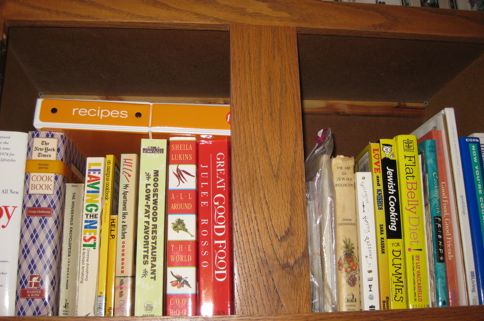 Lots of cookbooks for someone who relies on takeout sushi.
Lots of cookbooks for someone who relies on takeout sushi.
You’ve heard me say this before. Everything should have a home, but not everything has to live with you! The Pareto Principle, also called the 80/20 Rule, says that 80% of success comes from 20% of the effort, and it pretty much applies to your whole life. So, you may find that 80% of the time you are wearing (then washing, then re-wearing) the same basic 20% of your wardrobe; your kids are probably playing with the same 20% of their toys. That’s why paring things down gives you a much bigger bang for your buck than you expect…because you usually don’t miss the things you purge out, even though you probably thought you would, which is what kept you from downsizing in the first place.
This means letting go of books you read but hated, read but never plan to read again, got as a gift but don’t really want to read, or acquired for a different version of your life (one that you no longer lead). Even people who have no problem letting go of the rest of their possessions often still chafe at the idea of letting go of books, because readers know that in books, all the potential knowledge of the universe dwells. Well, that’s true, but if the knowledge is propping up your printer or gathering dust on a bedside table, that knowledge is being locked away in prison. Read it or set it free!
In previous Paper Doll posts, I’ve encouraged you to start the purging process by dividing books into three categories: Now, Then and Someday.
NOW books are the subjects, authors and titles that represent who you are today! They may be novels by authors you love or subjects you find compelling. For me, these would be my complete collection of Jane Austen, new novels like Charlie Lovett‘s forthcoming First Impressions, and recent books in my professional bailiwick, like The Organized Mind: Thinking Straight in the Age of Information Overload. Your own NOW books might be the latest thriller, some mouth-watering cookbooks, or a biography of Teddy Roosevelt (or, sigh, Kim Kardashian).
THEN books represent who you used to be. My THEN books covered all aspects of the television industry from the days I was a TV program director. By the time I became Paper Doll, I no longer needed to know the elements of a cause of action for a libel suit or how to calculate ratings and shares. If your youngest child is in middle school and the very idea of having another kid just made you shout obscenities at this family-friendly blog post, books about pregnancy and caring for newborns are so very THEN. As I’ve said before:
THEN books are like guests who have overstayed their welcomes. Consider the following alternatives for setting your THEN books free:
- Sell your books to a local used book store. Understand that you will get a tiny fraction of your original paid price. Instead, think of it as getting paid to recycle, like when you get a soda pop bottle deposit back.
- Sell your books online. (Amazon is the biggest and best-known option, but check out BookScouter for a Orbitz/Kayak-style search of all your price options.)
- Donate to your public library or school library. School libraries are often desperate for titles for their collections. Public libraries may be limited in what they’re allowed to select for circulation, but usually raise money by selling donated books at annual book sales.
- Donate books to hospital libraries, hospices, chemotherapy and dialysis treatment rooms, and community centers.
- Donate books to military personnel via projects like Books for Soldiers or Books for Troops.
- Donate your adult and YA titles, and textbooks, to incarcerated persons seeking to improve their literacy via programs like Prison Book Program.
- Set books free via Bookcrossing. (It’s not just a way to declutter; it’s a way to be part of “an unlikely global sociology experiment.”)
- Join the Little Free Library movement and share books with your neighbors and random passers-by.
SOMEDAY books represent who you wish (or once wished) to be someday. These are the publishing equivalent of the exercise videos that gather dust next to the TV. They’re the guides to speaking Italian or Urdu that you bought in hopes of learning an exotic language, the cookbooks for cuisines that are too complicated, too fattening or too much fuss for you to make…or the books on topics that represent your less relevant, if not less realistic, dreams.
Remember: Someday isn’t a date on the calendar. If you’ve decided that you’re starting a home-based business, books on writing business plans belong in your NOW collection; if you’ve been talking about starting a business for ten years but have never made any movement towards your goals, sell these books and let them fund a more current dream. Make space for your real life!
ORGANIZE YOUR LIBRARY SPACE & YOUR READING SPACE
These two zones may overlap, but unless you live (and read) in a dorm room or have a teeny studio apartment, your library and your reading area probably aren’t the same spaces. Start with two basic organizing guidelines:
- Things should live with others like them. As a professional organizer, this is a lesson I teach over and over, and it’s often an Ah-ha/lightbulb moment for clients. Put all your coffee mugs in the same cabinet. Let your shoes, except the ones on your feet right now, live in a little shoe commune in your closet. Your books should, generally, live together.
If you lack massive home library space, there’s no reason you can’t emulate official libraries with multiple collections in disparate spaces (e.g., children’s books in the kids’ rooms, cookbooks in the kitchen, non-fiction (including yearbooks and photo albums) in the den or living room). The key is that unless it’s the book you are currently reading, and unless it’s in your hand, your lap, your bag or under your eyeglasses on your bedside table, one lone book is likely to get buried and ignored. Books have stories to share — when they aren’t on the job, let them hang out with their friends.
- Things should live where they’re used. Reality check. If you have a big, comfy reading chair by the window in your bedroom — and yet you never sit in the big comfy reading chair, and the chair is covered with sedimentary rock-like layers of your wardrobe from the last few days, it’s not your reading chair. It’s your laundry chair.
Keep your main personal/family library where it best fits your home, but have your circulating library, your handful of borrowed library books, your current book club selection, and the novel you’ve been hacking away at, page by page, for months, in one small, defined space where you are actually reading. If you get all your reading done while rocking your baby to sleep, it’s alright to have your grownup books on shelf in the nursery next to currently nibbled-and-drooled-upon baby books. Your six-month-old won’t complain.
And if the only time you have to read your books is on your lunch hour, you have permission from a random blogger on the internet to keep your books, tidied by bookends, at the back of your desk against your cubicle wall.
[But don’t store books in your bathroom, even if you read them in the tub (or, y’know, elsewhere). Humidity and heat are bad for books.]
KNOW WHAT YOU HAVE SO YOU CAN READ WHAT YOU WANT
Finally, your library space will better serve you if you know what’s in it. The smaller your keep your collection, the less effort you’ll need to expend on putting your books in all but a rudimentary order, but if decluttering your library is an ongoing challenge, at least give yourself a chance to find what you want to read when the inspiration (and opportunity) strikes. The classic Paper Doll post, Shhhhh… We’re organizing the library… provides a good head start on no-tech, low-tech and more advanced ways to keep up with your library inventory; an eventual update on that post is in the works.
For more advice on keeping book clutter at bay so that you can find and focus on what you really want to read, be sure to revisit:
- Reducing Book Clutter (Part 1): Book Rentals for Grownups
- Reducing Book Clutter (Part 2): Book Rentals for Kids
- Reducing Book Clutter (Part 3): Trading Books Online (But keep to the “one-in, one-out” rule.)
- Reducing Book Clutter (Part 4): Borrowing & Returning–A Library Love Letter
- Reducing Book Clutter (Part 5): Electronic Books
- Reducing Book Clutter (Part 6): Audio Books
Next time, we’ll discuss how to carve organized space in your schedule so that reading doesn’t lose out to other activities in the competition for your time.
3rd Annual Be A Fool For (Organizing) Your Books Extravaganza
I would be most content if my children grew up to be the kind of people who think decorating consists mostly of building enough bookshelves.
~Anna Quindlen
It’s become our habit at Paper Doll to celebrate an upcoming April Fool’s Day with a post on wacky and wondrous ways for organizing a book collection. In 2008, we visited the now-famous Stairbookcase, talked about organizing by color and chatted a bit about virtually organizing one’s library. Last year, we delighted in upside-down bookshelves, houses of books, and bookshelves that wrapped right around the reader.
This year, we have another embarrassment of riches with regard to idiosyncratic, quirky and just plain weird ways of organizing (if we can really call it that) our books.
Hanging Around
This year’s major theme was a fait accompli. Every endeavor to research quirky book collections bought up link after link of ways to suspend books (and sometimes disbelief). It’s difficult to assure ourselves that these hanging methods do not damage the spines of books. Thus, think of this post is a museum tour and not a how-to or should-do. No aesthetic should supersede the structural integrity of your reading material.
Das Rote Paket, a German housewares company noted for its engaging designs, offers the Buchhalter, a combination bookmark and book holder. Indeed, to paraphrase the manufacturer, what holds your place in the book is what holds your book in place.
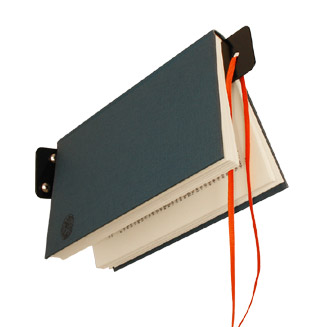
Imagine a steel ruler with the last few inches bent at 90 degrees. The shorter bent part affixes to the wall, and the book hangs, of its own accord, on the marked page. It comes in black, white and orange. Sadly, Paper Doll‘s preference of pink, as illustrated but not listed on the product page, appears to be either no longer manufactured or a bit of bait-and-switch.
Rather than shelving one book at a time — one by the front door, when watching for the school bus to arrive, one next to the tub when you need Calgon (and a good book) to take you away — Umbra’s Flybrary Bookshelf puts a number of these little horizontal “You Must Be This Tall (To Read This Novel)” book-suspending bars together:

The Flybrary Bookshelf seems to sell out frequently, but you should be able to purchase it from a variety of retailers, including RevDesign and Heliotrope.
The nifty home design and dcor site Crib Candy pointed me towards Korean design studio Samulnoli’s Book Hangers. Designed by Wonsuk Cho, they offer an intriguingly modern (if bizarre) way to come out of the closet and let your (book)freak flag fly — by putting your books back in the closet.
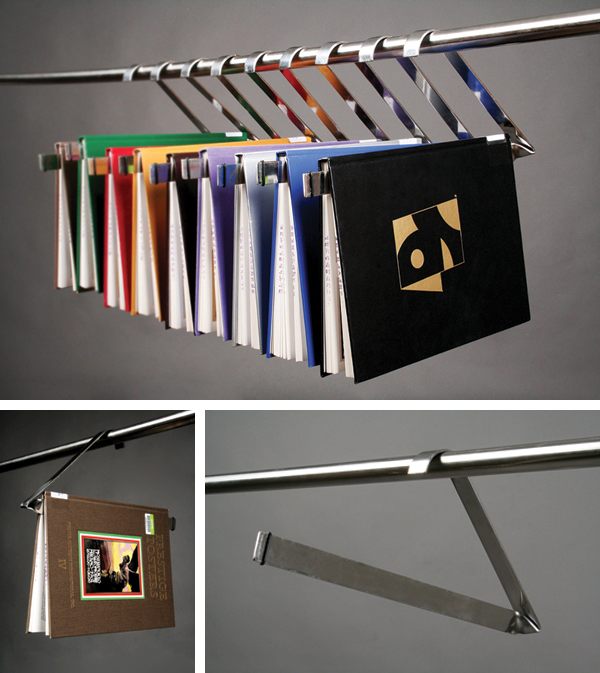
It appears Samulnoli either had no plans to manufacture the Book Hangers or prefers to keep them a secret from the buying public. Still, the artistic line of the trouser hanger style is nifty to behold.
Samulnoli combines hanging with hugging for the Movement Bookcase. Bent nails were painted and doll hands and feet attached to create limbs posed at oddly lifelike angles. The nails, attached to a backing board, can be positioned to allow the books to serve as torsos, hanging between the arms and balancing on the legs. Here, books not only contain characters; they become characters.
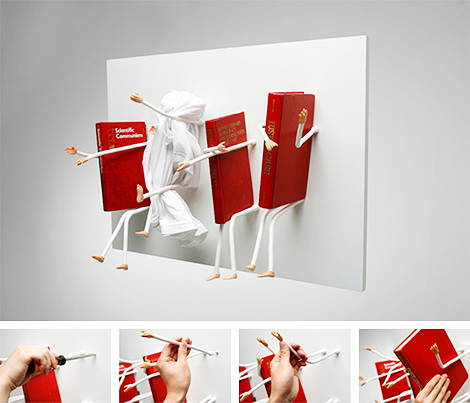
Designer Sungmin Hong’s own description is as charming as the book display is quirky and unfeasible:
Shall We Take Tea In the Library?
I really don’t know what to make of Nar, a combination coffee table and bookshelf from the nal & Bler Studio.

Aesthetically unusual and daring, it combines two of my concerns–damaging books by hanging them and damaging books by spilling frappuccinos on them. Indeed, at nal & Bler’s site, I learned that this anxiety provocation is intentional! Of this winner of the 2005 Istanbul Design Week Best Design Award, the creators say that the
Okay, then.
No Visible Means Of Support
In recent years, floating bookshelves have become all the rage in design circles (or so Paper Doll has been told by people who actually know such things).
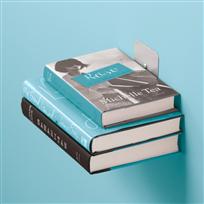
Chiasso’s Invisible Bookshelf claims to hold up to 20 pounds of books (in other words, your reading list for Thursdays). Just affix one of your larger hardcover books into the shelf bracket, and then add a stack of books. Two hidden rivets hold the hardcover book in place, turning your bottom book into the actual shelf. Put up a few of these around a room to create a funky library. Paper Doll can even imagine some hipster putting up a circular pattern of twelve Invisible Bookshelves on one wall, and then placing a clock in the middle.
Similar floating shelves in steel or nickel, made by Umbra, are available from Amazon and elsewhere. 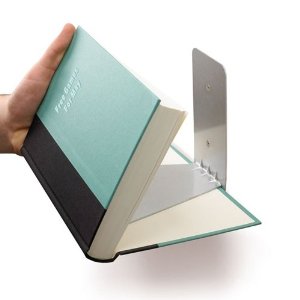
And of course, you can design your own with a little help from this DIY Network video …if, unlike Paper Doll, you aren’t frightened by a sentence that begins with “All you need is a nail gun…”). I kid, of course. We are gearing up for April Fool’s Day, right? If you’d really like to try this, Reader’s Digest’s Family Handyman offers plans and step-by-step instructions for making your own floating bookshelves.
Tall Tales From Tall Books
Although not designed specifically for books, I was enthralled by London’s Catherine Green-designed Rolling Shelf.
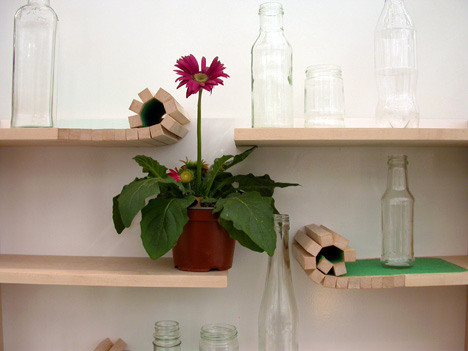
While I personally prefer bookshelves to be all-books, all-the-time, with no knickknacks to interrupt the flow, the appeal of this construction is easy to see. One end of the Rolling Shelf is made of multiple narrow blocks of wood held together with fabric to create a flexible hinge, roll-able, to make room for taller items, as necessary. The Brobdingnagian giants of Jonathan Swift’s Gulliver’s Travels would surely approve.
Up & At ‘Em
Not every enchanting design is for hanging your books up. Some just lead you to put them up…up…and away. The always-magnificent Apartment Therapy blog has us looking up to the rafters for bookshelves made out of plywood planks attached to the wooden supports of a loft above:
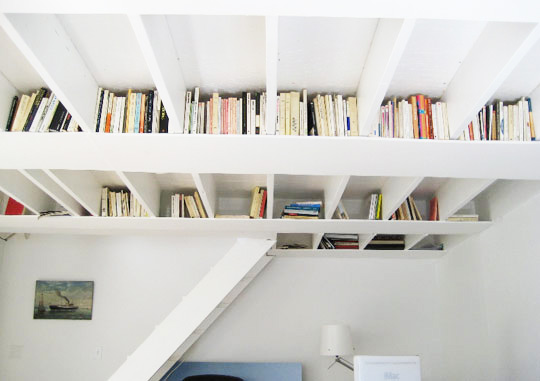
The author notes that the ceiling is a lower than usual, and obviously Paper Doll would never encourage shelving books anywhere that might entail standing on something less than secure. If you have any heavy-footed Fee-Fi-Fo-Fummers shaking the house, I’d also be inclined to keep the books secured from sliding forward and off of the shelves, perhaps with a bungee cord.
Not Quite A Soak In The Tub
Earlier, I mentioned the “Calgon, Take Me Away” aspect of enjoying a good book in the bath. Swedish artist/designer Malin Lundmark seems to have taken that idea to its logical, if also impractical, conclusion with this Library Bathtub Armchair.
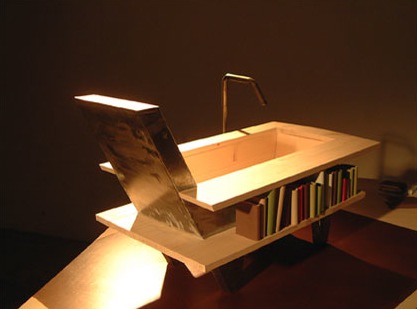
One assumes that this doesn’t have working plumbing (unless you resign yourself to reading only plastic or rubber baby bath-books). And how would you get in…or out, even if you only hoped to use it as an armchair? Only Lundmark knows for sure, and she isn’t telling.
From Furniture to Whole Buildings
Sometimes, you don’t want to read a book about architecture; you may want to see some architecture made from books. For that, take a peek at The Book Cell. This bit of eco-architecture was created by artist Matej Kren as part of his Book Cell Project, originally on display at Lisbon’s Centro de Arte Moderna.

Yep, the little building is created solely from books. Of course, we saw little cabins made of books in last year’s Fool for (Organizing) Books post, but the Book Cell is a little different. The novels used for this project were all borrowed from the Foundation Calouste Gulbenkian. At the end of the installation, the design was set to be taken apart, and the books returned to the Foundation for their original purpose…for spreading knowledge and ideas.
Kren built the octagonal framework, filled it with a vast selection of books, and then removed the frame. Of course, this wasn’t Kren’s first rodeo. He’d already made his name in the late 90’s, installing Idiom, a tower of books, in the entrance hall of the Prague Municipal Library, and his Gravity Mixer,

was a rotunda made entirely from books, at the 2000 Expo’s Czech Pavilion in Hanover, Germany.
Climbing The Walls…With Books
And finally, if you have the opposite problem of most of us, and rather than having too many books to shelve or organize, you have too few, you can take advantage of book-themed wallpaper, such as the magnificent, hand-printed faux library wallpaper of Deborah Bowness:

For colorful (and eerily realistic) designs, the UK’s Tracy Kendall has three different styles of wallpaper: neatly stacked paperback books,
 , messy piles of hardcovers, and even vertical stacks of magazines.
, messy piles of hardcovers, and even vertical stacks of magazines.There are also bookcase photo half murals with self-adhesive backing, like this one from Creative Wallcovering, which you can quickly affix to your wall in four parts.

It’s a few days away, but I hope all my readers have a lovely, safe-pranks-only, April Fool’s Day. Paper Doll remains…a fool for books.



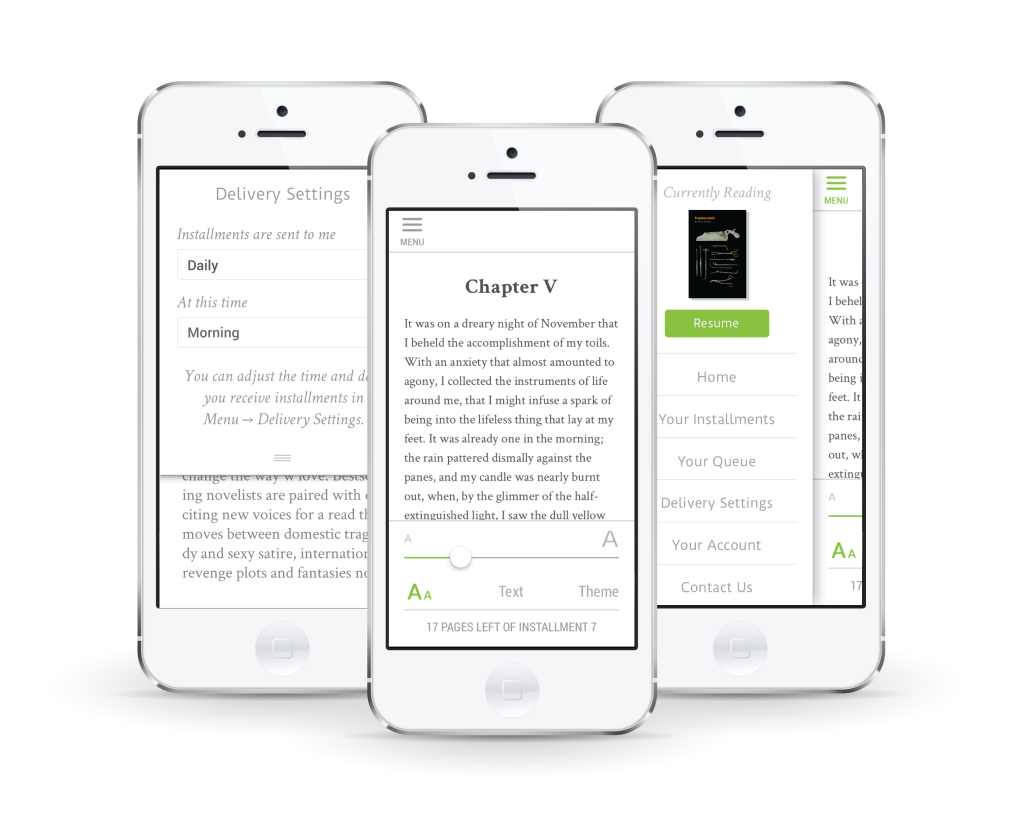



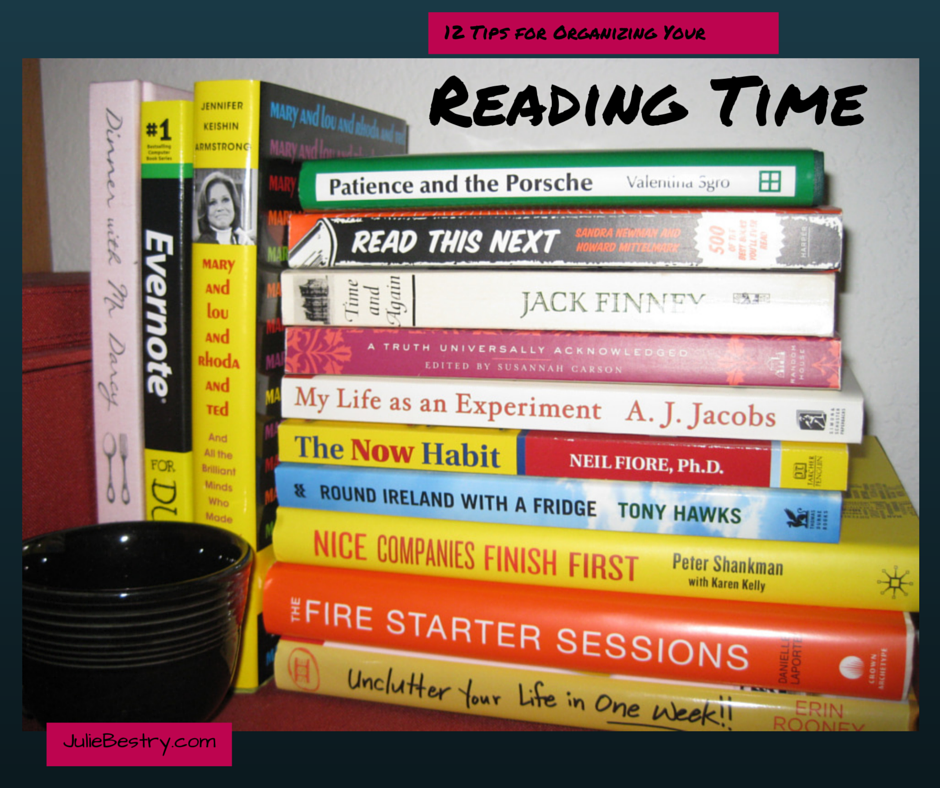

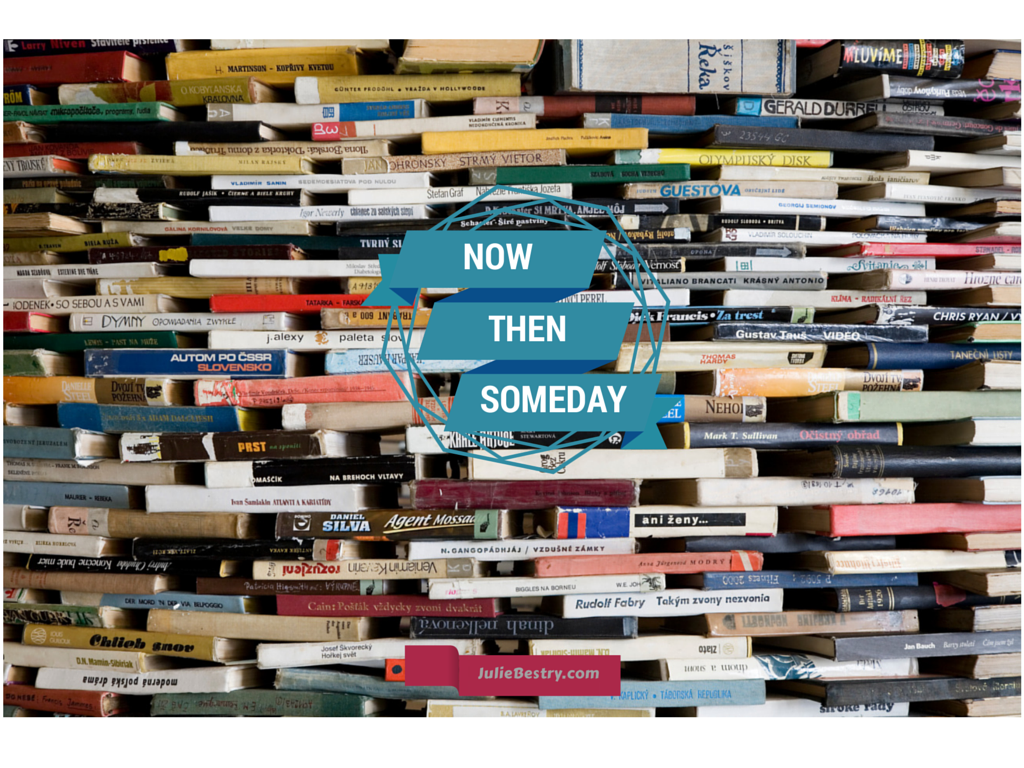



Follow Me